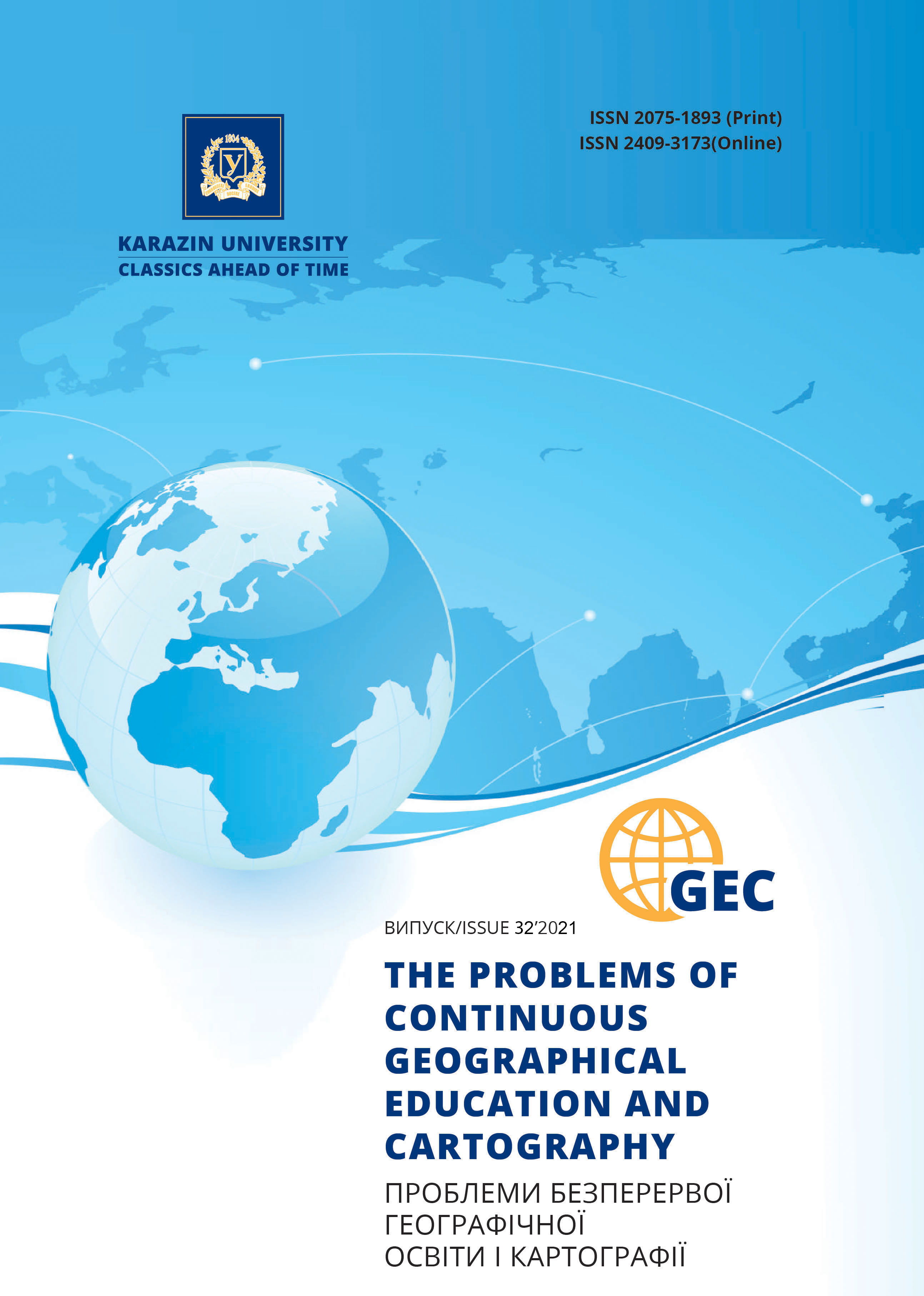Management of sustainable territorial development applying regional clusters model of M. Enright
Abstract
The purpose of the article is socio-geographical and economic justification of trends, models, mechanisms and priorities for improving managerial system of natural economic systems and territorial economic complexes in the context of decentralization based on adaptation of the clusters model of M. Enright. Main material. Mechanism for managing united territorial communities` natural and economic systems development to ensure sustainable geospatial development of territories based on the example of Kherson region has been applied in the article. It has been proven that the effectiveness of reforms’ progress can be ensured by further consolidation of united territorial communities (UTC) and their clustering. Moreover, the clusters can go outside current administrative districts` boundary, which since 2017 has been fully regulated by the law. To prove the mechanism of UTCs consolidation, it has been proposed to use the model of regional clusters of M. Enright, which was adapted for united territorial communities. To determine the prospects for further UTCs consolidation in Kherson region, followed by the definition of economically proved new zoning, the cluster analysis has been applied. The following criteria for clustering have been chosen: income per capita; own income per capita; infrastructure subsidy per capita. Conclusions. Socio-geographical and economic reasons for the reforming tools of the administrative-territorial system based on the example of Kherson region have revealed and substantiated the relevance of cluster approach in the process of UTCs and their associations` formation. UTCs associations aim to stimulate their development, rationally use available and potential resources, to ensure joint investment activities and project-management. It has been proposed to implement UTCs consolidation on the basis of cluster approach. Clustering, as the example of Kherson region, has been carried out based on the key socio-economic indicators per capita, namely: own incomes, infrastructure subsidy and basic / reverse subsidy. This allowed us to identify and map clusters of the formed UTCs and identify prospects for area without UTCs incorporation (within relevant village councils). UTCs consolidation was based on the characteristics of capacity, self-sufficiency, sustainable development, territorial and functional balance of community interests. This will allow to develop methodological and procedural recommendations for strategic documents at UTC level. Their relevance will be increased in the context of climate change and tackling national economic crisis.
Downloads
References
Tery`torial`na gromada yak bazova lanka administraty`vno-tery`torial`nogo ustroyu Ukrayiny`: problemy` ta perspekty`vy` reformuvannya (2016) [Territorial community as a base part of the administrative-territorial device of Ukraine: problems and prospects of reforming]. Ky`yiv: NISD, 61.
Batanov, O.V. (2008). Tery`torial`na gromada – pervy`nny`j sub’yekt municy`pal`noyi vlady` v Ukrayini: ponyattya ta oznaky` [A territorial community - primary subject of municipal authority in Ukraine: concept and attribute]. Available at: http://www.cvk.gov.ua/visnyk/pdf/2008_2/visnik_st_13.pdf
Murkovy`ch, L. Tery`torial`na gromada yak sub’yekt miscevogo samovryaduvannya v Ukrayini: teorety`chni aspekty` [Territorial community as the subject of local self-management in Ukraine: theoretical aspects]. Available at: http://www.dbuapa.dp.ua/vidavnictvo/2010/2010_02%285%29/10mliuta.pdf
Molodozhen, Yu.B. (2006). Ponyattya i sutnist` tery`torial`noyi gromady` v sy`stemi miscevogo samovryaduvannya Ukrayiny` [Concept and essence of a territorial community in system of local self-management of Ukraine]. University Scientific Notes: Journal of Khmelnitsky University, 2, 128-136.
Rudenko, L.G., Lisovs`ky`j, S.A., Marunyak, Ye.O. (2016). Vy`kly`ky` i zagrozy` prostorovogo rozvy`tku Ukrayiny` na shlyaxu do yevrointegraciyi [Challenges and threats of spatial development of Ukraine on the way to European integration]. Ukrainian Geographical Journal, 1, 41-46.
Volkov, V.P., Karbivnychyi, I.O, Karbivnychyi, R.O., Horbova, I.A. (2018). Conditions of the no-loss functioning of territorial formation. Вelostok: Вelostok, 190.
Goroshkova, L.A., Volkov, V.P., Karbivny`chy`j, R.O. (2018). Rol` mizhbyudzhetnogo regulyuvannya u ????inansovij spromozhnosti tery`torial`ny`x gromad [A role of the interbudgetary adjusting in financial possibility of territorial communities]. Bulletin of Priazovsky State Technical University. Series: Economic sciences, 36, 5-12.
Horoshkova, L., Volkov, V., Kapranova, L., Komelina, А. (2018). The Reverse Subsidy`s Impact of United Territorial Community`s Budget Generations. International Journal of Engineering & Technology, 7 (4.8), 539-543.
Goroshkova, L.A., Volkov, V.P., Xloby`stov, Ye.V., Kuty`k, V.V. (2019). Prognosty`chni modeli finansovogo regulyuvannya byudzhetiv tery`torial`ny`x gromad [Prognostic models of financial regulation of territorial communities’ budget ]. Economic Bulletin of Pereyaslav-Khmelnytsky State Pedagogical University, 42, 179-190.
Horoshkova, L., Khlobystov, Ie., Filipishyna, L., Bikulov, D. (2019). Distribution of Local Expenditure for Sustainable Development of United Territorial Communities (economic and mathematical approach). Advances in Economics, Business and Management Research, 99, 20-25.
Goroshkova, L.A., Xloby`stov, Ye.V. (2019). Social`no-ekonomichny`j potencial rozvy`tku ob’yednany`x tery`torial`ny`x gromad (na pry`kladi Zaporiz`koyi oblasti) [United territorial communities socio-economic development potential (the case of Zaporizhzhia region)]. Ukrainian Geographical Journal, 4,19-28.
Horoshkova, L., Khlobystov, Ie., Volkov, V., Kutyk, V. (2019). Kaizen technologies in natural and economic systems management: approaches to economic and mathematical modeling. Economics and Region, 2 (73), 116-122.
Horoshkova, L., Lisovsky, S., Khlobystov, Ie. (2019). Potentsial efektyvnosti reformuvannia administratyvno-terytorialnoho ustroiu (na prykladi Zaporizkoi oblasti) [Capacity of reforms ef????iciency of administrative and territorial structure (the case of Zaporizhzhia region)]. The Problems of Continuous Geographical Education and Cartography, 30, 32-42.
Porter, M. (2001) Konkurencija [Competition]. Moskva: Izdatel’skij dom «Vil’jams», 560.
Porter, M. (1993)/ Mezhdunarodnaja konkurencija [International competition]. Moskva: Mezhunarodnye otnoshenija, 896.
Enright, M.J. (2000). Survey on the Characterization of Regional Clusters: Initial Results. Working Paper. Institute of Economic Policy and Business Strategy: Competitiveness Program University of Hong Kong, 21.
Andersson, T., Schwaag-Serger, S., Sorvik, J., Hansson, E.W. (2004). The Cluster Policies Whitebook. IKED, 266.

This work is licensed under a Creative Commons Attribution 4.0 International License.





